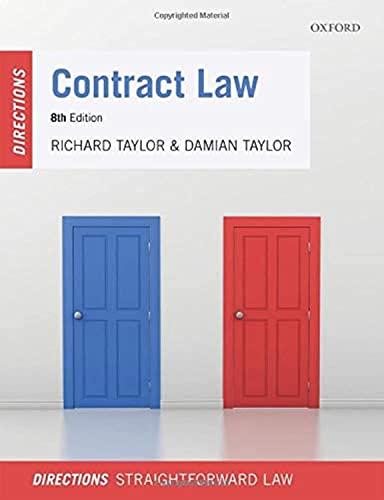Question
SECTION 3: ENVIRONMENTAL LAW AND WILDFIRES In this scenario, we have a policy that is being developed by San Mateo County that requires private property
SECTION 3: ENVIRONMENTAL LAW AND WILDFIRES
In this scenario, we have a policy that is being developed by San Mateo County that requires private property owners to conduct mandatory brush clearing within 100 feet of their homes or businesses. The property owner can either do the work themselves, or pay for the County to do it for them (at a reasonable rate). The County Board of Supervisors has declared this an item of extreme urgency, and has declared a state of emergency due to the wildfire history and current risk the unmanaged vegetation poses to the communities.
Based on this limited information, please answer the following:
- Explain why this might require the County to conduct an environmental review of this project under CEQA. Based on your understanding of CEQA, what level of review and which type of environmental document would likely be necessary? (e.g. is the project exempt, or would it require a negative declaration, mitigated negative declaration, or an environmental impact report?)
- Would the County have to consider air quality impacts as part of their CEQA review if they were going to use controlled burns as part of their management of the lands? What about greenhouse gas emissions and climate impacts?
- Let's assume that under this plan, approximately 7,000 acres of undisturbed sensitive habitat will be permanently lost, which supports the endangered southwestern flycatcher (a tiny red bird that lives and nests in the shrubs). Since this fuels reduction program was NOT contemplated under the original Habitat Conservation Plan for the County, does the proposed project violate the Endangered Species Act? Does it matter that this project is being done as a matter of emergency concern? Be specific, and discuss the features of the Endangered Species Act.
SECTION 4: ENDANGERED SPECIES AND WATERSHEDS
You have been hired as a consultant for the US Forest Service in the Humboldt-Toiyabe National Forest in Nevada. As you recall the USFS operates under a "multiple-use philosophy" for land management. The property in question is approximately 150,000 acres, that includes the following permitted activities: timber harvest, recreation (hiking, camping, fishing, etc.), and cattle grazing. There is a proposal to conduct large-scale fuel reduction on approximately 25,000 acres of high-risk areas, most of which is adjacent to the camping areas, creeks, and rangelands. They are proposing to use both mechanical removal and controlled burns.
- In order for this project to move forward, they must address the impacts to a known endangered species of trout (Lahontan Cutthroat Trout). What kind of review under the Endangered Species Act might be required of the USFS in order to review potential impacts to the federally listed species?
- What section of the ESA would allow for this to occur?
- The controlled burns are anticipated to remove a significant amount of "flashy fuels" like shrubs and grasses, including the targeted removal of a non-native, invasive grass. While this may have positive benefits for the ecosystem, the watershed may experience impacts from sedimentation, erosion, and nutrient runoff. This has implications under the Clean Water Act and the Endangered Species Act (remember the trout...). Answer the following:
- What section of the Clean Water Act is responsible for addressing the erosion issue and other related concerns?
- If the waterbody is already in non-compliance for sedimentation and nutrients, what can the USFS to do in order to ensure that they don't make things worse?
- Let's assume that the Trout may be significantly (although temporarily) impacted by this change in water quality. The first year or so will be pretty impactful, but after that the habitat in the creek is expected to recover and provide even better breeding grounds for the trout. How would you balance the needs for fire management and fuels reduction, and the protection of the endangered species?
- Let's further assume that the whole reason they need to do fuels reduction and management at this point is because the USFS failed to properly manage the land in the first place, and that past practices (timber harvest and grazing) resulted in the flashy fuels, non-native grasses, and other issues that we see today. Can this be considered a "restoration" project, and if so, does that matter with regard to environmental review and compliance?
Step by Step Solution
There are 3 Steps involved in it
Step: 1

Get Instant Access to Expert-Tailored Solutions
See step-by-step solutions with expert insights and AI powered tools for academic success
Step: 2

Step: 3

Ace Your Homework with AI
Get the answers you need in no time with our AI-driven, step-by-step assistance
Get Started


